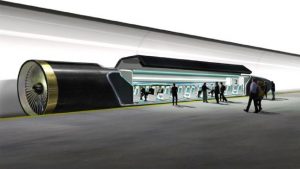Engineering Hyperloop
Hyperloop is being touted as a revolutionary new method of travel but what is the engineering story behind Hyperloop and what engineering innovations has it borne so far?
Hyperloop consists of a carriage carrying around 28 passengers which is hurtled through a near-vacuum tube by a series of electromagnets using passive magnetic levitation.

Because the tube that the carriage operates within is pressure tight (unlike conventional pipelines the challenge for engineers is to stop anything getting in the tube, rather than out), there’s very little in the way of air resistance.
Engineers project that a Hyperloop carriage, carrying a full complement of passengers, would be able to reach around 760mph – making a trip from Edinburgh to London just 28 minutes.
In the vacuum tube, capsules would be subject to a level of resistance only as great as that experienced by a lorry travelling down the motorway at 60mph. In fact, once the Hyperloop capsule is up to speed it can effectively coast for 100 miles without any magnetic energy injected because of the lack of air resistance. Meaning propulsion via electromagnets is only required across 5% of the track.
With figures that make HS2 look like a steam engine, the concept of Hyperloop travel has inspired many governments and companies to invest in its potential. Most notable project being Hyperloop Transportation Technologies’ projects in California and Toulouse.
What innovations have stemmed from Hyperloop projects so far?
Passive magnetic levitation:
Maglev trains in Japan use a levitation system powered by a series of power stations which are installed along the side of the track. Each unit feeds electricity to copper cables in the track which become electromagnets once charged. The Hyperloop system however has a passive magnet on each carriage and an aluminium track containing loops of wire – operating more like a pair of regular magnets than an electromagnet requiring a constant supply of electricity to work. Hyperloop engineers claim this is a safer and more efficient system.
Vibranium, a new super-safe and strong material:
Safety is critical for Hyperloop to be feasible and so special materials are required to safely and reliably deal with such special conditions. Vibranium, a material which is said to be 8 times stronger than aluminium and 10 times stronger than steel, has been developed by a Slovakian company as the answer. Hyperloop carriages will be constructed out of a sandwich of Vibranium, the dual layer approach ensuring structural integrity if one layer fails. Creators claim the material will also transmit data on carriage temperature, stability and integrity.
The potential of Hyperloop as a practical method of transport is still very much in development but we will watch the engineering innovations it creates excitedly and bring as much as it here, to our surface engineering blog, as possible.
Require surface engineering services? At Surface Technology we are passionate about engineering and we work with manufacturing and engineering companies across a wide spectrum of industries to deliver the best coating, plating or thermal spray solution and service for their requirements.
Contact us now for a quote or to discuss your surface engineering requirements further.
Register below for our monthly email and stay up-to-date with the latest surface engineering white papers, case studies and innovation news.

